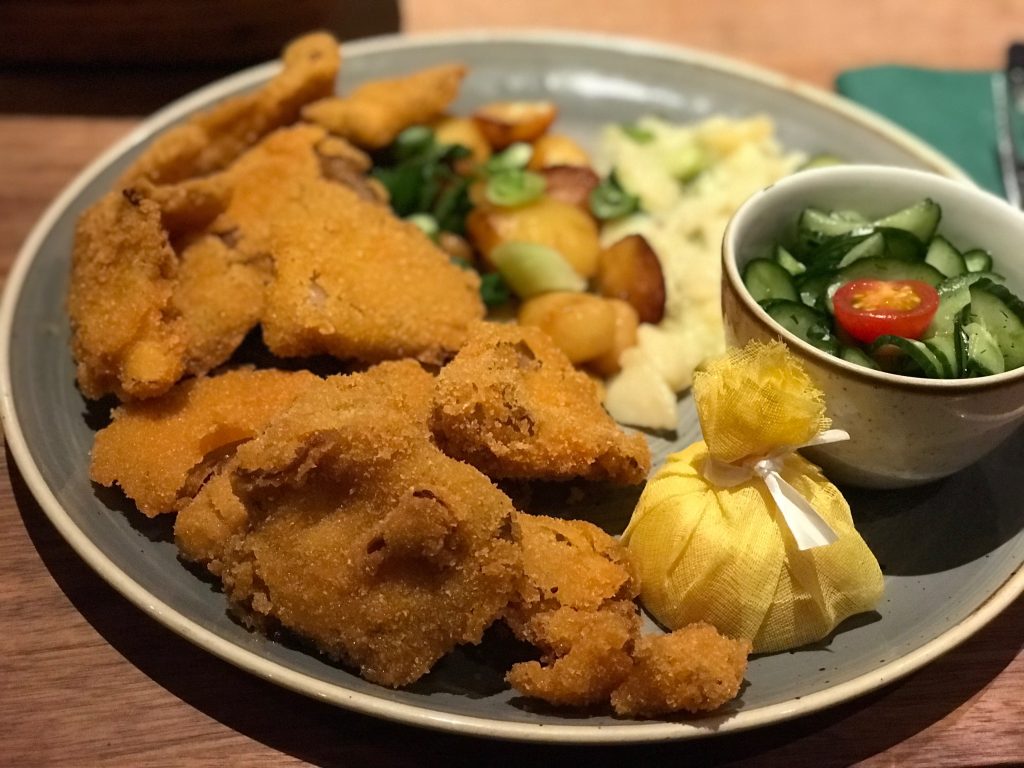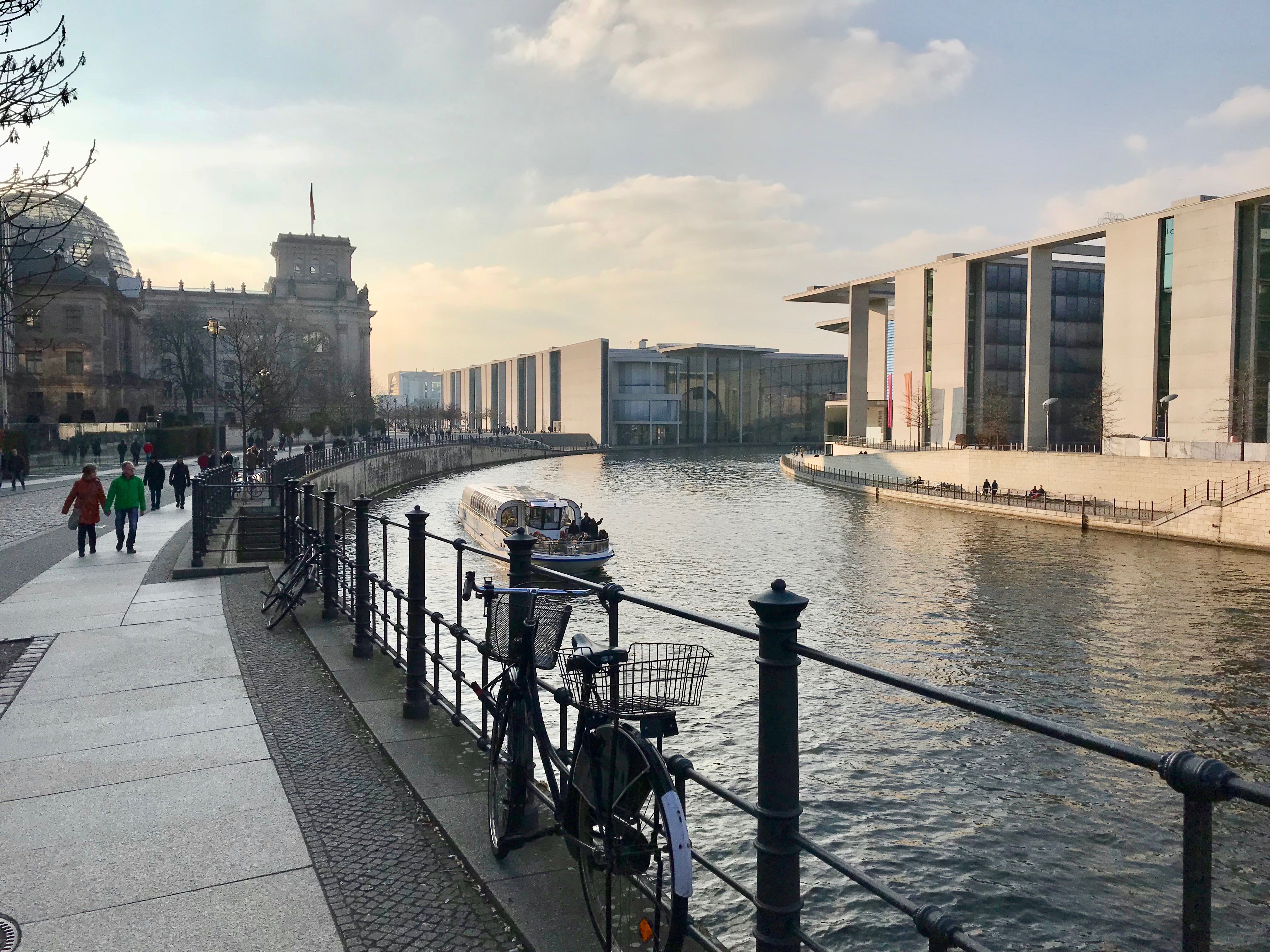Berlin: The City of 100 Faces

Guest Blogger and ACIS Tour Manager Peter Ede has been traveling the world for as long as he can remember. In fact, he started taking high-school Americans around Europe when studying at Cambridge University 26 years ago, and it’s now a habit he just can’t shake! Peter loves sharing his interest in people, architecture, history and current affairs with others and looks forward to many new adventures abroad with ACIS.
Why is Berlin all the rage? Not that long ago the place was hardly on the radar as a city to visit in Europe. American visitors in particular were drawn instead to visit the south of Germany: the elegant, sophisticated, well-heeled charm of Munich and the beauty of the mountains, rather than this city which still bore the open scars of devastation from WWII and division during the Cold War.
In recent times, however, Berlin has come from nowhere, and experienced ever increasing numbers of people coming to find out what all the buzz is about. Overnight stays have almost doubled in the past ten years: a growth other tourist destinations could only dream of. Berlin has even knocked the Eternal City, Rome, out of the top 3, and now ranks behind only London and Paris for overnight visitor bed stays in Europe. It’s now a “must-see” on the list of cities to be visited.
So what is the draw? The first thing to understand about Berlin is it’s (still) not a “pretty city.” It has some undeniably beautiful buildings, but this isn’t a place like Amsterdam or Venice, where every corner you turn has you reaching for your iPhone to capture a snap of yet another stunning vista. It’s ugly – dare I say it, pig-ugly – in places. And it’s very much a work in progress, with building sites and cranes apparently growing up out of the ground like over-grown trees. But my goodness, it is fascinating and the energy here is unbelievable. It is genuinely a city like no other: the city of 100 faces.
Let’s take this one building as an example of those many faces. Located at Torstraße 1, a 10 minute walk from the old heart of East Berlin, it doesn’t look that interesting at first glance.
But if you’re in the company of someone who knows the city, they could tell you that it was built as a well-known Jewish owned department store in the 1920s. It was a modern 7-storey shop, with a restaurant on the roof, built in the “New Objectivity” style. The building was of course then confiscated by the Nazis in the 1930s, and became the national HQ of the Hitler Youth movement. Heavy street fighting took place here between the Wehrmacht and the Red Army in April 1945. During the 1950s, the building’s use changed radically again, when it became the seat of the Politburo of Communist East Germany. And having been derelict and in danger of being torn down, today it is the beautifully restored, designer, Soho House Berlin, the hip and trendy international members club and high-end hotel.
You have to just stop yourself for a moment, and imagine all the different people – and even what clothes they were wearing – as they walked through those same front doors over the past 100 years. Then you begin to understand Berlin and its inhabitants have lived through in recent history and to grasp what makes this place unique.
Everywhere you go in Berlin you will see these different faces of the city. No other has been through what Berlin has. You’ll uncover memories of the tolerant capital of Frederick the Great of Prussia, who in the 18th century was years ahead of his time and welcomed persecuted minorities from across Europe to come and make their home in his city. Jews, Catholics and Protestants all came and laid the foundations for the cosmopolitan city that Berlin remains to its core. The influence of the French Protestants lives on in Gendarmenmarkt, the city’s most elegant square, for example; in the many Berliners who carry French last names; or in the neo-classical world-class museums of the Museum Island.
From this era of tolerance and enlightenment values it’s a quick leap to the more authoritarian, militaristic Germany of the Kaiser, and the heavy style of buildings of the era. Many were destroyed, but astonishingly, the former baroque Imperial Palace is now almost ready to be unveiled, having been entirely rebuilt from the ground up at a cost of $650,000,000. It will house a museum that will open in 2019.
The stunningly restored Imperial-era Reichstag Building is one of my favourite visits in the whole city: from the graffiti left by Red Army soldiers to the glass dome built by a British architect, it again tells so much history in just one place. Visitors are encouraged to walk round the dome, which is located directly above the politicians of today’s Germany: the symbolism is clear and is deliberate. The people are above the politicians, and the latter serve the former, not vice versa.
After 1918 we enter the period of the Weimar Republic. There are specialist tours available devoted to the Berlin of the Roaring 20s, the setting for “Cabaret” and the burst of energy, political instability, and hedonism that followed the First World War.
Then we come to the city that very uneasily became the Capital of Hitler’s Third Reich. Berlin – unlike Munich – was never convinced by Nazism. There are however two huge intact Nazi era buildings in the city: the 1936 Olympic stadium where Jesse Owens confounded the Führer with his gold medals for the USA, and Göring’s Luftwaffe HQ, which is now the ministry for taxes!
Apart from these two monoliths, there are memorials all over the city, including hundreds of heart-breaking “Stumbling Stones” in the sidewalks outside apartments which mark the former homes of holocaust victims, with their name, date of birth, deportation and death on them.
Berlin was known at this time as the “Red City” – the working-class city of the socialists and communists. Berliners for the most part had very little time for the anti-semitism and extreme right wing policies of the Nazis, most of whom came to the city from elsewhere. Berlin was the site of the only mass protest at Rosenstraße against the deportation of Jews during the entire Nazi period, by thousands of ordinary Berlin women, screaming, “Give us our husbands back.”
When a group of SA youths descended on the New Synagogue on Reichskristallnacht to try to burn it down, a typically plucky Berlin Police Sergeant pulled out his pistol and threatened to shoot them. He declared that it was a “historic monument” that had been opened by Prince Bismarck himself, and was under the city’s protection. As a result, the synagogue still stands and is at the heart of today’s incredibly vibrant Jewish population of Berlin.
Berlin suffered a staggering 363 air-raids at the hands of the Allies in World War II. 40% of the population had fled by the end of the war, when the Soviets arrived, and what was left was pulverized in a gigantic battle that involved over 3 million men on both sides. Stop at any postcard shop and look at the photographs of the time. It is a Hiroshima type landscape, and impossible to imagine that you are even standing in the same city.
Then came the Cold War. Berlin was located deep behind the Iron Curtain and was the flash-point for Allied-Soviet tensions. A month before the Berlin Wall went up in 1961, dividing the city in two, the East German leader declared, “No one has the intention of erecting a wall!” A month before it came unexpectedly came down in 1989, his successor confidently predicted it would still be there in 100 years. There are several portions of the Wall still remaining including the colourful East Side Gallery, but most impressively at Bernauerstraße, where the full extent of this brutal division can be seen that tore in two communities, friends and families. That site is an absolute must-see for any visitor.
After the Wall fell, in the early 1990s, Berlin was like a dead city. It was as if all of the energy and life-blood had finally left the place after the trauma of the preceding 60 years. Vast tracts – especially in the centre- were simply wasteland. The difference between East and West was so visible: in the East there were decaying historic buildings and huge grey concrete tower-blocks with their identically laid-out apartments.
My favourite is close to the Alexanderplatz: look carefully and you’ll see a “stray” window on the 9th floor where no other apartments have one. It’s a favourite urban myth that this was the apartment of Ingrid Mielke, the daughter of the Communist Minister for State Security. She wanted a kitchen window – and as we all know, “all animals are equal, but some animals are more equal than others” – so she got one. Sadly the tale is complete fiction, but it’s so eminently plausible that many believe it without question!
West Berlin was wealthier, but still poor by West German standards. If you wanted to avoid military service in West Germany you would move here, so there were many young less well-off people, and also a thriving immigrant (mainly Turkish) population. There was actually a serious debate about whether the reunified German capital should even be relocated here – with Frankfurt in the running instead. Few politicians wanted to move from comfy, civilised Bonn on the French border to an effective wasteland, where the climate can be harsh, wild boar roam the suburbs in winter, and whose name “Berlin” even means “swamp” in Old Slavic. But move they did – and behind them came the cranes.
A brand new capital was built – but one in which the government quarter actually feels more like a capital than any other European city. Countries moved their embassies here, each trying to outdo the other with their flashy and imaginative architecture. The sparkling new US one sits on its historic site, right next to the Brandenburg Gate. Old buildings were restored – such as the neo-baroque Berlin Cathedral, pictured here with the former communist TV Tower behind it.
It has taken a couple of decades, but behind them came the private investment. For many years Berlin was a decidedly “grungy” alternative city, where Street Art and graffiti covered buildings, squats abounded, and young people came because living here was so cheap. This aspect can still very much be found in certain areas (a Street Art workshop is one of the most fascinating things you can do here, learning all about the subculture, skills and techniques involved) – but gentrification is now in full swing.
The former mayor once said, “Berlin is poor, but sexy.” Those words seem a long time ago now… trendy cafés, boutique shops, and stylish restaurants are transforming entire areas, but not in an overtly corporate way. Berlin is still maintaining its hip urban edge, even if it is a lot more “respectable” way than the run-down place it once was. The creative industries are massive here, filling old formerly derelict warehouses by the Spree River. It has been hailed as the most rewarding city in the world for lovers of classical music, with its renowned Philharmonic and no less than three opera houses – as well as the scene of a lot more contemporary music. It is also, perhaps surprisingly, rapidly becoming the Vegan Capital of Europe. Some of the best vegetarian and vegan meals I’ve ever experienced have been here in recent years (see the vegan Wienerschnitzel below): yet another of its 100 varied faces.
Berlin in 2018 is positively booming: unemployment has halved in recent years and the growth in the local economy is out-pacing every other federal state in Germany (Berlin is a city, but also a state in its own right). Where many companies were nervous to come here for years after reunification, the city cannot now keep up building all the offices, hotels and apartments that are needed. Those cranes won’t be leaving any time soon. It is simply one of the coolest, most “happening” places on the entire continent. There is a staggering amount to do and see, whether your interest is history, art, food, the vast range of music, the exciting nightlife, new and restored architecture, or simply chilling in a hipster hangout. You can sense the energy everywhere: it is a city on the move, and one that despite its unbelievably tragic and difficult past is heading in a wonderfully positive direction.
Let’s just head back to that building we started with. For someone born just round the corner from it, in the 1920s, they have experienced all of this first hand. Like that building, the entire city has changed radically as it has swung from one extreme to the other. Berlin: the liberal, cosmopolitan capital of the roaring 20s; the capital of the Nazi 3rd Reich; carpet bombed and depopulated during WW2; isolated for 40 years deep behind the Iron Curtain; divided for 28 years by a Wall that split families and communities; the city of spies; a place that had almost died spiritually; and now it is back – with energy, style, and a unique, creative urban hipness.
That unremarkable looking building on Torstraße summarises all of these changes. They are almost certainly too much for one person to actually live through, but will no doubt keep the visitor enthralled. Berlin: it is truly the city of 100 faces, and a place like no other.
























What a wonderful article, Peter! This will be handy for my daughter who first went on an ACIS trip 5 years ago and now is spending the month in Germany on her own, after graduating high school and feeling confident from her ACIS trip knowledge from years ago. She is there right now..I just sent her the article!
I haven’t been to Berlin in 20 years but apparently it would be a new discovery for me as well!
Danke sehr!!!
Very beautiful photos ! Berlin is an unforgettable city. Thank you for sharing this article. She inspired me to another trip here.
This is so true – and it is what makes the city so great, the fact that it has so many faces and sides. It is hard not to find your tribe and vibe in Berlin, whether as a tourist or resident. Coliving Berlin, https://www.vondereurope.com/location/berlin , is a great way to meet people and worth checking out for those interested in staying in the city longer term.